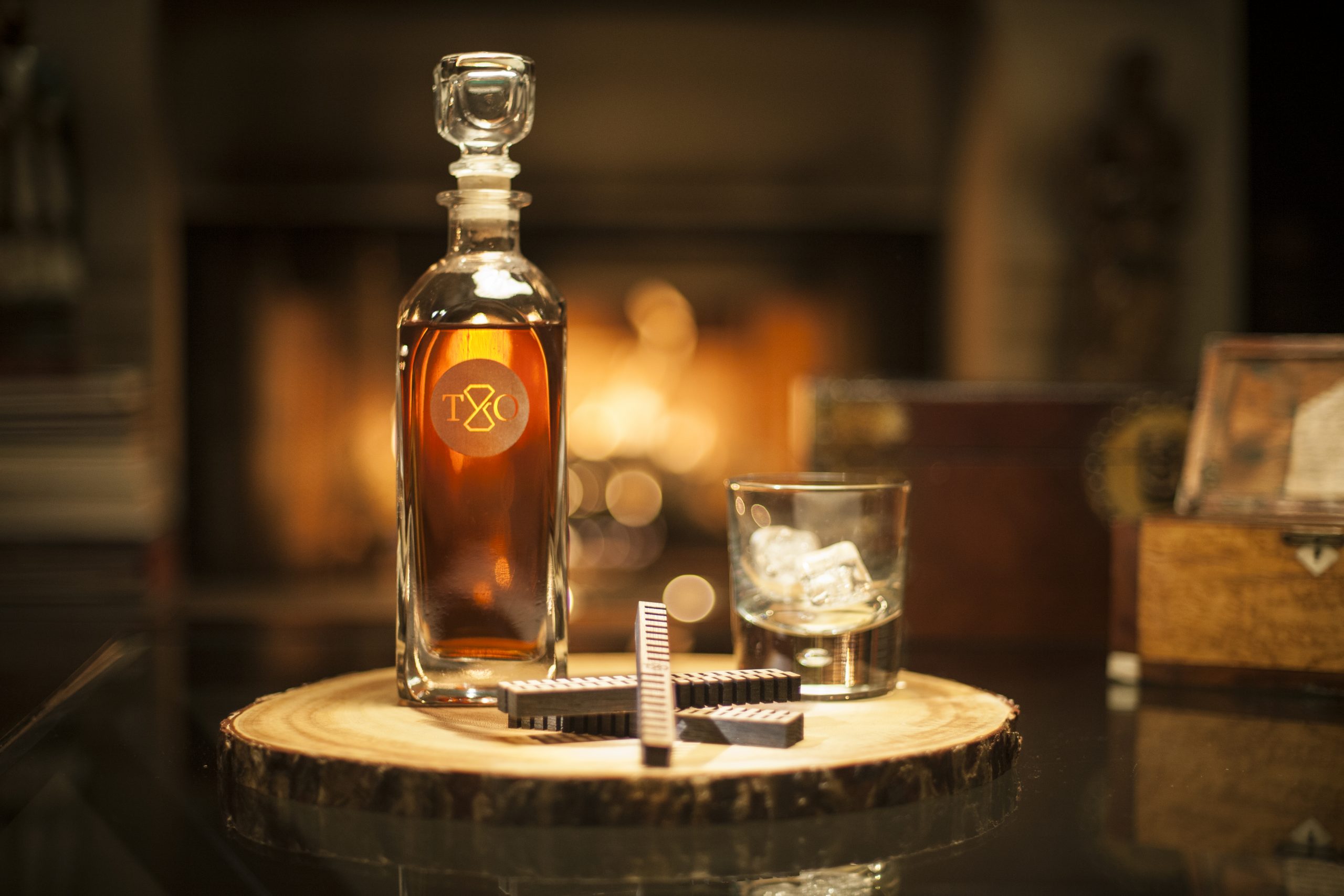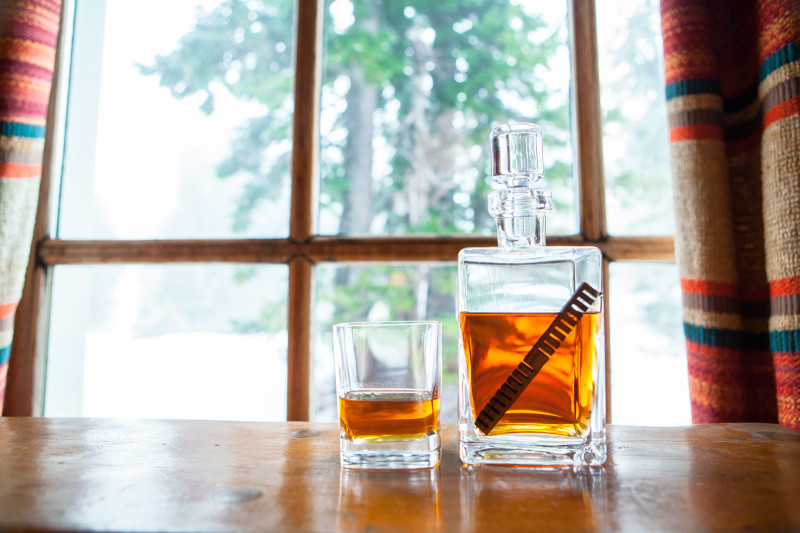


You pour a customer a top-shelf whiskey. It’s a nice, caramel brown color. The customer raises the glass and smells spice and vanilla. He takes a sip—it’s smooth and hot with a woody flavor.
Most of whiskey’s color, scent, and taste comes from the barrel-aging process. Top-shelf whiskey is usually aged for 10 to 20 years, sitting in an oak barrel in a distillery. This barrel-aging breaks down the rougher flavors of the alcohol, makes it more smooth, gives it its brownish color, adds unique flavors, and filters out toxins that cause nasty hangovers. Due to the many years of aging and the natural evaporation of 30%-40% of the product, these whiskies can cost hundreds of dollars.
A startup in Portland is challenging the traditional mindset that oak’s flavor, color, and filtering in whiskey can only come from years of barrel aging. With specially designed pieces of oak wood called Whiskey Elements, they’re accelerating the maturation process, reducing the impurities, and improving the flavor of whiskey in less than 24 hours.
We had a chance to chat with David Jackson and Joshua Thorne, Time & Oak’s co-founders. Here’s what they had to say about what sparked the idea for the company, how the whiskey community responded, and the science behind their product.
David Jackson: The original idea happened when we walked into the liquor store and asked ourselves a very simple question: “What’s the difference between top-shelf and well whiskey?” The answer came simply, “TIME & OAK.” That’s when it hit us—if the goal is for the whiskey to filter in and out of the wood, be infused with flavor, and develop those rich colors, then the barrel may not be the best design to achieve this process.
See, a bottle of moonshine or un-aged whiskey can sit on a shelf for years without any real change to its taste. However, if it spends that time in a barrel, you will see rich flavors and colors develop. Aging is not so much about the time. It is about the craft, the wood, and the spirit.
David Jackson: Our idea came quickly. That said, deciding how to deliver it was pondered, researched, and experimented with for nearly a year leading up to the formation and launch of our first product, the Whiskey Element.
David Jackson: In July 2014, Joshua and I decided to go ahead with this idea and turn it into a company. Time & Oak was incorporated on August 6th, 2014. In just under two months after its inception, the Whiskey Element was announced on October 1, 2014 via Kickstarter.
David Jackson: After arriving at the true concept, my co-founder, Josh Thorne, went to work cutting, burning, and cooking all kinds of oak. The process of finding the right temperature and time for the wood, as well as the best way to expose the capillaries, took about three months. During that time, we held hundreds of blind tastings resulting in a definitive crowd winner: The Signature Element was born.

David Jackson: We have faced most of the challenges any new startup would: growing and finding office space; hiring the right team members; working on a shoestring budget; long hours, cheap pizza, and great jokes shared by those in the office along the way. Our greatest challenge has probably been overcoming the misunderstanding of our product. People think it can’t work or is some kind of gimmick, and they often label us before they know us or give us a try. We source and create our Whiskey Elements with the same materials and methods of traditional whiskey companies. We just make it easy and convenient for anyone to access the beautiful flavors of barrel aging.
To date, we have held over 40,000 taste tests, with amazing feedback. It is in letting people taste the difference one at a time that we’re winning hearts and opening up people to this long tradition. We’ve been recognized by huge industry names, including the National Brand Director of Whiskeys at Bacardi and the President of 1921 Tequila. But of course they had to be willing to try it first, and not just once.
Experimenting with Whiskey Elements should take place multiple times and in various spirits. People should treat the Element like they would a barrel; if you want a dark rum type finish on a sprit, place the Element in dark rum briefly before using it. Get creative and really explore the possibilities—they’re endless.
Joshua Thorne: I enlisted in the United States Air Force in 2005 and spent four years working in Aerospace Mechanics. After a trip to Iraq and a few stories to tell, I finished my four-year commitment and started writing and making films. In 2010, I sold my first film to Lionsgate that I wrote, produced, financed, and even acted in myself. Working in the film industry really allowed me to be creative. After selling my film, I was ready for a new adventure. I really wanted to start a small business.
The inception of this idea came from my business partner Tony Peniche. After his initial pitch, I instantly identified multiple hurdles with the concept, but I also felt they could be overcome. So I dove into the science of barrel-making and how the wood interacts with the spirit to accomplish such great flavor. After a few months, the Whiskey Element was born.
Joshua Thorne: Trade secret. Literally. I can tell you it comes from the Midwest, and it’s one of the main places that barrel makers get their barrel wood today.

Joshua Thorne: Nothing! Our product is 100% Natural American White Oak. The flavors you get come naturally from within the wood. Different temperatures unlock different flavors.
Joshua Thorne: Acetaldehyde is a chemical that naturally exists in alcohol. It’s also a leading cause of hangovers. The organic wood and charred surfaces act as a natural filtration device. The wood actually bonds to Acetaldehyde, keeping it from the alcohol and limiting the amount a person will drink.
Joshua Thorne: Officially, no. Unofficially, yes. I say this because after the first use, all the vanillins, sugars, and tannins will be removed from the wood and imparted into the spirit. So the second use will have a diminished return. But if you want to drop it into a wine for a few hours and then throw it into a bottle of rum to create your very own thing, go for it. Some people really like moving it from a whiskey bottle to a tequila.
Joshua Thorne: Without American Oak, there is no whiskey! Well, aged whiskey. Un-aged whiskey is clear. It’s often called moonshine, white lightning, or fire water. But whiskey, as we know it, is brown and beautiful. Many distillers agree that up to 80% of the flavor, color, character, and aroma comes directly from the wood. But this process takes many years. With our Elements you can have that reaction in as little as 24 hours. We have far greater surface area and interaction with the wood than a 52-gallon barrel does. Now, you can replicate this process at home, but with a tool that is far more effective and a cost that is much more reasonable for the typical consumer.
David Jackson: We get emails from people all the time. They’re using Elements in a way we hadn’t anticipated, which is awesome. We didn’t realize how many culinary applications there could be. One lady told us she uses them for home canning. Another customer said he uses Whiskey Elements to add a kick to his homemade BBQ sauce by soaking them in Jack Daniels and then soaking them in his sauce. One of our restaurant accounts, the Edgewater Hotel, in Seattle, ages their balsamic and olive oil with Whiskey Elements.
The Elements are also going beyond just whiskey. People are exploring with tequila, wine, vodka, and beer. They’re also cross-infusing liquors by putting an element in one type of alcohol and then putting it in another.
David Jackson: Mixologists know how to use Whiskey Elements because they’re creators. They’re passionate and they know how to experiment, taste, test, and use the Element as a finishing tool. With our product, they have the ability to create a variety of unique, barrel-aged flavors only found at their bar or restaurant, and they can make it quickly and turn it over again.
Vodka, such as Tito’s, aged with an Element, is great for making Bloody Mary’s or Moscow Mules. The taste is unique and delicious. Think about it—for centuries, oak has been a key flavor in alcohol. We use wooden oak barrels in so many applications, like creating the perfect balance in a fine wine or finishing our favorite spirits like tequila, rum and (of course) whiskey.
Whiskey Elements are great for bars because of their convenience and cost. Let’s say you sometimes make small batches of barrel-aged spirits or cocktails, and it takes 42 days to make 30 cocktails. If you use a Whiskey Element instead, it can take a total of 4 days to make 30 cocktails, and it would cost you a fraction of the price.

David Jackson: Right now, we’re partnering with a bunch of restaurants. 23Hoyt, Pope House, Private MAC club in Portland, and the Edgewater Hotel in Seattle all create featured cocktails using Whiskey Elements. For example, Nick Perdue at 23Hoyte makes the “Lewis & Clarke,” one of my personal favorites, with Whiskey Element-aged rye whiskey. Colby Hayden at the Private MAC club makes a “Grumpy Margarita” with 2oz. of Whiskey Element-aged “Grumpy” tequila. We’re also now working on a cocktail program for Houlihan’s Restaurant and Bar.
When we originally released the product, it was a consumer product. We signed a deal with Safeway and other national retailers. Now, we’re planning on targeting restaurants, bar owners, and cocktail programs.
Joshua Thorne: Everyone in the office has their own favorite, and our customers find theirs daily. For me, it has to be Crown Royal and our Signature Element. After about a day, it become really smooth and the sweetness is ramped up. I can’t stop showing it to guests when they come over.
David Jackson: Basically, we’re lifting up the skirt on the whiskey industry. We’re helping people understand the important role wood plays in creating many of our favorite flavors. Just like the distiller starts with an amazing base spirit, we want you to do the same. Start with what you love, something worth making your own and appreciating.
For years, someone else has set the standard for what makes a “good” spirit. Yet, there are countless spirit varieties and ways to enjoy them. It shouldn’t be about what’s right and wrong, but about what spirit you like and how you want to enjoy it. We have such a deep respect for whiskey and its tradition; we want to continue that tradition by giving people access to create an all natural and unique taste. A taste that can only be achieved with oak, after all time and oak are fundamental to the flavor of many of our favorite spirits.
Joshua Thorne: Robots, flying cars, time travel, and good whiskey! In all seriousness, we’re looking at the long-standing popularity of aged spirits, particularly whiskey, and our love for it. Unfortunately, both our product and the barrels many distilleries use are crafted from limited tree strands. By encouraging efficient use of wood with Whiskey Elements, and by being a zero-waste manufacturer, we can both conserve and prolong access to crafting delicious aged spirits well into the future.
In order to ensure conservation of wild lands, we have also partnered with Project Footprint, an organization that protects and conserves wild lands.
Oak has been used for thousands of years to store food and transport various goods and liquids. The unique flavor of oak has a certain place in our palate as well as our history. We want to revive and continue the tradition of barrel-aged flavor and quality well into the future, and, for the first time, in a very convenient way. Ever wondered what barrel-stored olive oil tastes like? Create one at home, much like the Edgewater hotel in Seattle has done for their guests. What we have learned thus far is that the future for Time and Oak is bright and the uses for our product lines are limitless.
Here at BevSpot, we share a similar mindset. The alcohol industry is rooted in traditional practices, such as barrel aging and pen and paper inventory. Traditions will always be an important and respected part of our industry, but innovation, whether it’s laser-cut oak or bar management software, can help us to improve and advance the space.
Are you ready to get innovative? Use Whiskey Elements as a finishing tool to create signature drinks while using BevSpot’s bar management software to reveal insights, save time, and increase profits. Want to know more about BevSpot? Visit our retailers page. Interested in Time & Oak? Check out their website.

